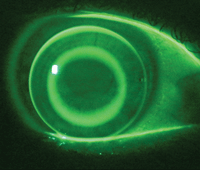Since their introduction in the latter 20th century, orthokeratology (ortho-K) lenses have become widely used for controlling myopia progression. To achieve a proper fit, the lenses must be customized to accommodate each patient’s unique corneal parameters, traditionally requiring meticulous adjustments by an experienced clinician. In recent years, however, a new lens fitting approach using computer-aided design and manufacturing techniques has emerged, allowing optometrists with less experience—or busier clinic schedules—to offer these lenses as a treatment option for myopia. A recent study comparing the safety and efficacy of this software-based fitting approach to traditional methods found that while the two methods achieved similar outcomes, the former offered slightly better performance in correcting myopia and improving uncorrected visual acuity (UCVA).
 |
| Using computer-aided design and manufacturing techniques to fit ortho-K lenses could reduce the reliance on highly skilled optometrists, shorten the time required for lens fitting and minimize the need for a large number of trial lenses, researchers suggest. Photo: John Mountford. Click image to enlarge. |
The multicenter, examiner-masked, randomized controlled study enrolled 280 participants from three hospitals in China with one year of follow-up and spherical equivalent (SE) ranging from 0.5D to 4.0D. Participants were divided into a computer-aided orthokeratology fitting group (trial group; 109 participants) and a traditional lens fitting group (control group; 106 participants). Each underwent a comprehensive ocular examination. Successful lens correction was defined as the residual refraction with the ortho-K lens, not exceeding ±0.5D, and/or an uncorrected visual acuity of 20/25 or better.
The results showed that compared to baseline data, participants in both groups showed a significant improvement in UCVA, with a reduced SE and flatter central corneal curvature observed after one year of ortho-K wear. The trial group had a higher success rate in correcting UCVA compared to the control group (93.6% vs. 84.0%), as well as slightly better correction in refraction (77.1% vs. 66.0%) at one-month follow-up. Notably, the researchers found no significant differences between the two groups in terms of axial length elongation, corneal changes or adverse event incidence.
The researchers wrote in their paper on the study, published in Contact Lens & Anterior Eye, that the computer-aided fitting method “outperforms traditional lens fitting approach in certain aspects, such as reducing the reliance on highly skilled optometrists, shortening the time required for lens fitting and minimizing the need for a large number of trial lenses.” However, they added, “it did not demonstrate statistically significant superiority in controlling axial elongation among younger participants (aged eight to 13) and then may offer no advantage over traditional ortho-K lenses, indicating the need for further investigation into its benefits in the wider population.”
Sun Y, Peng Z, Zhao B, et al. Comparison of trial lens and computer-aided fitting in orthokeratology: a multi-center, randomized, examiner-masked, controlled study. Cont Lens Anterior Eye. May 24, 2024. [Epub ahead of print]. |

